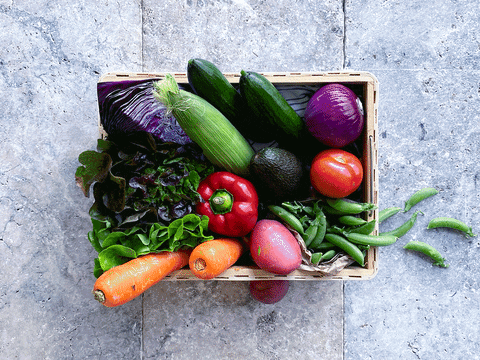
Published on Apr 08, 2024
Last modified on Sep 18, 2024
Fiber and Menopause: Here’s What You Should Know
8 min read

We know we need it, and that it plays a part in keeping us ~regular~, but beyond that, fiber can be a bit of an enigma. We’re here to break it down – pun intended – and to get to the bottom of this food’s health benefits and important role during the menopausal transition.
What exactly is fiber?
Fiber is a type of carbohydrate, typically derived from plants. Unlike other forms of carbohydrates, fiber is not digested in the small intestine – it actually passes all the way through to our large intestine, where it may be partially broken down by gut bacteria.
Fiber comes in two forms:
- Soluble fiber: dissolves in water, can aid in glucose level reduction, stabilize blood sugar spikes, lower blood cholesterol, and promote satiety – so you stay full longer. Fruits and veggies are the main source of soluble fiber, but foods like oatmeal, chia seeds, lentils, and nuts are also great sources.
- Insoluble fiber: does not dissolve in water, and helps move food through the digestive system to prevent constipation. Common sources include leafy greens, quinoa, brown rice, and fruit skins.
There’s one more important classification when it comes to defining fiber: fermentable vs non-fermentable:
- Fermentable fiber: acts as food for that large intestine gut bacteria that breaks it down – or ferments it. Generally speaking, soluble fiber is more fermentable than non-soluble.
- Non-fermentable fiber: adds bulk to stool to ease passage and make bowel movements regular.
Okay, now that we’ve gotten that out of the way…
Why is fiber important during the menopause transition?
1. Supports digestion and bowel movements
Constipation and digestive discomfort are common complaints during menopause and perimenopause, and a diet rich in fiber can help alleviate these menopause symptoms by promoting optimal gut function and transit time. (In other words, a little less time in the bathroom.)
2. Helps with weight management
High-fiber foods take longer to digest and tend to be more filling, promoting feelings of satiety. This is especially helpful for women experiencing weight gain during perimenopause and can prevent overconsumption.
3. Boosts gut health
As hormone levels fluctuate during perimenopause, the decrease in estrogen and progesterone can actually change our gut microbiome composition, potentially impacting function and overall gut health. (What don’t hormones affect?!) Consuming fiber is one way we can improve the diversity of our individual microbiota (the set of organisms living in our bodies).
How? Well, remember when we talked about how “fermentable fiber” acts as food for large intestine gut bacteria? That “feeding” process is essential for keeping all of that good bacteria alive, which in turn maintains estrobolome, a collection of bacteria in our gut that helps metabolize and modulate the body’s estrogen levels.
4. Prevents risk of colorectal cancer
We know that after age 50, our risk for developing colon cancer increases, and the rate of colon cancer diagnoses among younger individuals is on the rise. Consuming fiber is one way we can bolster our colorectal health; as the nutrient is processed in our colons during digestion, our body makes short-chain fatty acids, which can reduce the risk of colorectal cancer.
5. Promotes cardiovascular health
Many people don’t know that heart disease is the leading cause of death for women, and we are at increased risk as we age. This being said, maintaining a healthy, fiber-rich diet is one way we can lower our risk of developing heart problems.
Studies suggest that people who consume dietary fiber regularly can lower their chances of developing cardiovascular disease and hypertension. Fiber-rich diets lower LDL cholesterol (aka “bad cholesterol”), thereby lowering the risk of coronary artery disease and atherosclerosis. Fiber consumption also helps to lower blood pressure levels and improve blood glucose control; more on that below…
6. Aids in blood sugar control
Remember estrogen and progesterone, the menopause lead stars? Well, they influence how cells respond to insulin; as levels of these hormones decline during menopause, cells can become more insulin resistant, which in turn leads to elevated blood sugar levels.
Fiber-rich foods typically have a lower glycemic index (GI), meaning they cause a slower and more moderate increase in blood sugar levels compared to high-GI foods, like baked goods or soda. This is largely due to their lower content of digestible carbohydrates, which slows down the digestion process. As we discussed above, consuming fiber helps to control blood sugar and cholesterol, which can help prevent or manage type 1 and type 2 diabetes complications.
What’s more, research has revealed a correlation between hot flashes/night sweats and higher levels of insulin resistance and higher glucose levels. So, maintaining a stable blood glucose level may also help reduce hot flashes.
7. May help prevent depression
Good news for anyone experiencing mood changes during perimenopause: there may be an inverse association between fiber intake and depression. While most Americans only consume 16 grams of fiber per day, some government data suggests that people who consume more than 21 grams are less likely to report symptoms of depression.
How much fiber do we need during menopause?
The short answer: aim to get around 21 grams of fiber per day.
The longer answer: the ideal dietary fiber intake for women is 14 grams per 1000 kcal, or 21 grams per day, and there are plenty of foods to help you up that figure:
- Fruits and vegetables: We can’t say this enough: fruits and vegetables are soooo important during the menopausal transition, in part due to their high fiber content and heart health-supporting antioxidants. Women should aim to get 3-4 portions of veggies and 1-2 portions of fruit daily. (Pro tip – raspberries have a whopping 8 grams per cup, so grab some frozen berries and make a smoothie!)
- Legumes: Try to incorporate legumes like chickpeas, lentils, and beans at least once per week. Many legumes are also high in protein which helps keep us full longer.
- Whole grains: Opt for fiber-rich whole grains, like barley, quinoa, and oats over refined grains and white flour.
What about fiber supplements?
If you don’t get enough fiber from your food, you may need a supplement to get the benefits. Of course, the market is completely saturated with supplements ranging in quality, which can make choosing one tricky. Here’s a couple things to keep in mind:
Fiber is not one size fits all…
So when you are selecting a supplement, make sure to select one that aligns with your specific needs:
- Konsyl, a powder-form fiber supplement, has a mix of soluble and insoluble fiber, and can move things along while absorbing extra cholesterol.
- Citrucel is a pill-form soluble fiber supplement that slows transit time of food, which can be a good choice for folks struggling with diarrhea or urgent bowel movements.
- Benefiber is a powder form fiber supplement that includes prebiotic fiber, which helps maintain good gut bacteria, aka probiotics. Probiotics are live microorganisms that aren’t naturally produced in the human body.
Do your research.
The Food and Drug Administration (FDA) does not verify that supplements contain what they say they do or whether they’re contaminated with heavy metals, bacteria, or pesticides, so, the onus is on consumers to practice vigilance when using supplements. About Herbs and Harvard Health are great sources for conducting your own research.
As with all supplements, you should consult a women’s health professional before taking anything new, especially if you are already taking medications or have any inflammatory bowel diseases (IBD).
It’s important to note that fiber supplements should not replace a balanced diet high in fiber-rich foods; getting it from food sources is ideal. Also, there is such a thing as too much fiber, which can lead to gas, bloating, and constipation. So, if you already eat enough, you can probably skip the pill!
The bottom line
Fiber is important for people at all life stages — but especially for those in the menopause transition — so that we can maintain gut and cardiovascular health, as well as weight and mental health. Aim for 21 grams per day, ideally from food sources like fruits and veggies and whole grains. If taking supplements, be sure to consult a healthcare professional (women’s health provider and/or Registered Dietitian Nutritionist) beforehand.
Interested in care? Learn more and book a visit with a board-certified, menopause-trained Elektra clinician.
READ MORE:


